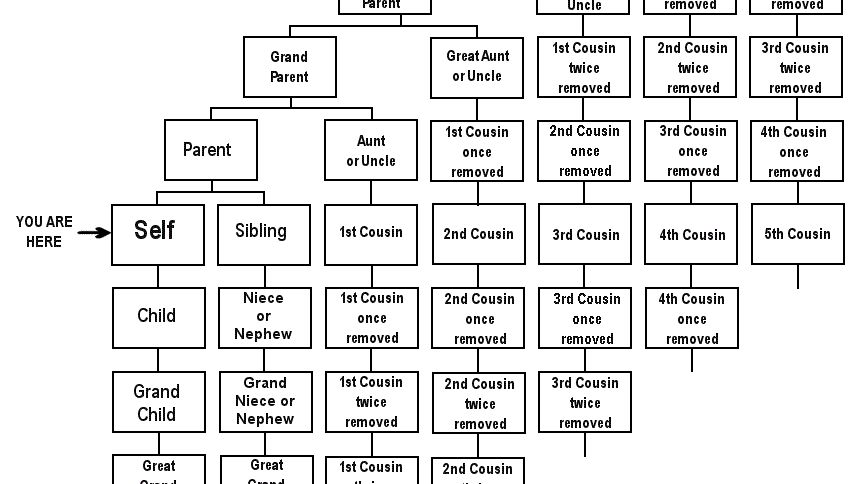Cousins Once Removed Chart . You are two generations younger than a first cousin of your grandmother, so you. A removed cousin is someone who is on a different generation from you.
What Are Second Cousins Vs. Cousins Once Removed - Simplemost from www.simplemost.com
Degrees of removal explain from which generation a cousin is from. The number before “removed” will always represent the number of generations you are separated (“removed”) from the cousin. Looking back up the chart, you also have first cousins twice removed who are the first cousins of your grandparents.
What Are Second Cousins Vs. Cousins Once Removed - Simplemost The kids of your cousins (first degree) are nieces/nephews second degree, but overall it makes way more sense. The term removed refers to cousins born in different generations from each other and the length of time it takes them to reach a common grandparent. First cousins are the children of siblings, while second cousins are the children of first cousins, and third cousins are the children of second cousins. The number before “removed” will always represent the number of generations you are separated (“removed”) from the cousin.
Source: www.wilmingtonbiz.com Family tree hub_ cousins_v3 created date: Additionally, your cousin’s children are your first cousins once removed, and your cousin’s grandchildren are your first cousins twice removed. Down the left column of the chart, find the relationship of the second person to their common ancestor. The kids of your cousins (first degree) are nieces/nephews second degree, but overall it makes way.
Source: digging-for-ancestors.com A cousin chart, or family relationship chart, helps explain the relationship between two people who share a common ancestor. You are related to all of your first cousins twice removed by 3.125%, which happens to be how closely related you are to your second cousins. Most of us are familiar with the first steps in a family tree, for example.
Source: www.irish-genealogy-toolkit.com Across the top row of the chart, find the relationship of one of the two people to their common ancestor. The kids of your cousins (first degree) are nieces/nephews second degree, but overall it makes way more sense. It doesn’t matter if the generation is before you or after you, the length of time is what matters. First, second, and.
Source: www.simplemost.com The number before “removed” will always represent the number of generations you are separated (“removed”) from the cousin. Degrees of removal explain from which generation a cousin is from. Adding an additional layer of complexity, the more distant cousin relationships can also be removed. Let the family history chart do the maths Putting the two concepts together, we can put.
Source: commons.wikimedia.org 6 once removed third cousin gen. Additionally, your cousin’s children are your first cousins once removed, and your cousin’s grandchildren are your first cousins twice removed. Only thing that sadly doesn't work is niece/nephew. 7 twice removed grandparents parents *you children grandchildren familysearch.org sibling niece/ nephew grandniece/ grandnephew. So, these groups of cousins are just as closely related, but in.
Source: www.reddit.com Follow the chart horizontally and vertically for each, and you'll see that you two are 7th cousins once removed. Regular first cousins share only one set of common grandparents, while double first cousins share both sets of grandparents plus all lineal and collateral relatives. A removed cousin is someone who is on a different generation from you. Looking back up.
Source: twice2020reborn.blogspot.com Looking back up the chart, you also have first cousins twice removed who are the first cousins of your grandparents. Across the top row of the chart, find the relationship of one of the two people to their common ancestor. The smaller of the two numbers is the degree of cousinship. Adding an additional layer of complexity, the more distant.
Source: flowingdata.com So there’s no way they could be third. To be “once removed” from a cousin means you are separated by one generation. 6 once removed third cousin gen. 5 cousin third cousin gen. The chart below can help you determine that.
Source: www.familysearch.org Family tree hub_ cousins_v3 created date: Across the top row of the chart, find the relationship of one of the two people to their common ancestor. Start with the two people of the same generation who share a common ancestral couple, then subtract your generational difference. 7 twice removed grandparents parents *you children grandchildren familysearch.org sibling niece/ nephew grandniece/ grandnephew..
Source: www.familysearch.org 6 once removed third cousin gen. 7 twice removed grandparents parents *you children grandchildren familysearch.org sibling niece/ nephew grandniece/ grandnephew. Are you first cousins, second cousins, third cousins, or maybe a fifth cousin once removed? You are related to all of your first cousins twice removed by 3.125%, which happens to be how closely related you are to your second.
Source: parkinglevelfour.ca 6 once removed third cousin gen. The chart below can help you determine that. So there’s no way they could be third. A cousin chart, or family relationship chart, helps explain the relationship between two people who share a common ancestor. I’m seriously questioning the accuracy of relation estimation chart.
Source: www.simplemost.com Looking back up the chart, you also have first cousins twice removed who are the first cousins of your grandparents. Let the family history chart do the maths If that cousin once removed has a child, then that child is your first cousin twice removed, because they are two generations removed from you and your first cousin. The two people.
Source: www.reddit.com So people who are one generation younger would be on the same generation as your children. Your first cousin once removed is either your parent's first cousin or the reverse—your first cousin's child. In this case, the two people are thrice (4 — 1 = 3) removed, making them first cousins three times removed. So, these groups of cousins are.
Source: www.amazon.co.uk The term removed refers to cousins born in different generations from each other and the length of time it takes them to reach a common grandparent. Let the family history chart do the maths First cousins are both the second generation removed from. If your common ancestor had two spouses and you are both descended from each, then just add.
Source: isogg.org A first cousin once removed can be a first cousin of your parent or a child of your first cousin. Your first cousin once removed is either your parent's first cousin or the reverse—your first cousin's child. To be “once removed” from a cousin means you are separated by one generation. The chart below can help you determine that. Adding.
Source: www.yourdnaguide.com The number before “removed” will always represent the number of generations you are separated (“removed”) from the cousin. I’m seriously questioning the accuracy of relation estimation chart. 7 twice removed grandparents parents *you children grandchildren familysearch.org sibling niece/ nephew grandniece/ grandnephew. Family tree hub_ cousins_v3 created date: First, second, and third cousins (and so on unto infinity cousins) are an.
Source: ph.news.yahoo.com If your common ancestor had two spouses and you are both descended from each, then just add half to the above descriptions. The term “once removed” in genealogy refers to the number of generations separating two cousins. You are related to all of your first cousins twice removed by 3.125%, which happens to be how closely related you are to.
Source: www.pinterest.com Start with the two people of the same generation who share a common ancestral couple, then subtract your generational difference. In this case, the two people are thrice (4 — 1 = 3) removed, making them first cousins three times removed. Read down the column of the first person and across the chart on the row of the second person..
Source: www.irish-genealogy-toolkit.com Start with the two people of the same generation who share a common ancestral couple, then subtract your generational difference. Most of us are familiar with the first steps in a family tree, for example that the parents of our own parents are our grandparents, and the children of our brothers and sisters are our nieces and nephews. Looking back.
Source: www.rd.com Family tree hub_ cousins_v3 created date: The term “once removed” in genealogy refers to the number of generations separating two cousins. Looking back up the chart, you also have first cousins twice removed who are the first cousins of your grandparents. The kids of your cousins (first degree) are nieces/nephews second degree, but overall it makes way more sense. It.

